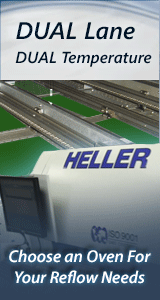Printed Circuit Board Assembly & PCB Design Forum
SMT electronics assembly manufacturing forum.
- SMTnet
- »
- Electronics Forum
- »
- Post reflow solder joint inspection
Post reflow solder joint inspection
![]() Has anyone in the industry had even a fair amount of success...
- Jan 28, 2004
by
swagner
Has anyone in the industry had even a fair amount of success...
- Jan 28, 2004
by
swagner
![]()
![]()
![]() 90% of the assemblies our company produces are class 3 and w...
- Feb 02, 2004
by
paul_bmc
90% of the assemblies our company produces are class 3 and w...
- Feb 02, 2004
by
paul_bmc
![]()
![]()
![]() We are not having a problem, we have a customer that would l...
- Feb 02, 2004
by
We are not having a problem, we have a customer that would l...
- Feb 02, 2004
by
![]()
![]() I find this disturbing when customers dictate your process a...
- Feb 02, 2004
by
I find this disturbing when customers dictate your process a...
- Feb 02, 2004
by
![]()
![]() About 2 years ago our company tried to go with a post reflow...
- Feb 03, 2004
by
paul_bmc
About 2 years ago our company tried to go with a post reflow...
- Feb 03, 2004
by
paul_bmc
![]()
![]()
![]() Paul, do you have any kind of false failure data for the app...
- Feb 03, 2004
by
Paul, do you have any kind of false failure data for the app...
- Feb 03, 2004
by
![]()
![]() We had the data at the time and it was quite high. More fal...
- Feb 03, 2004
by
paul_bmc
We had the data at the time and it was quite high. More fal...
- Feb 03, 2004
by
paul_bmc
![]()
- SMTnet
- »
- Electronics Forum
- »
- Post reflow solder joint inspection







